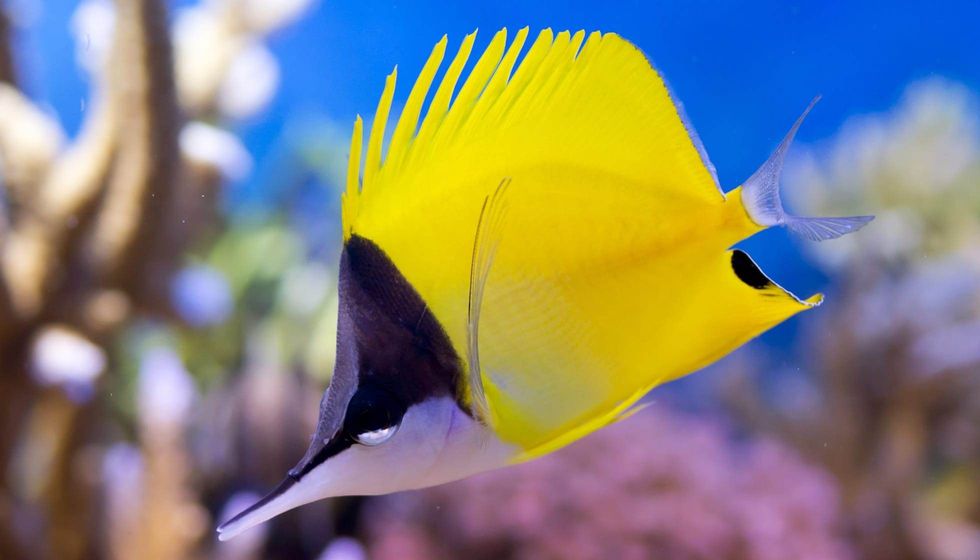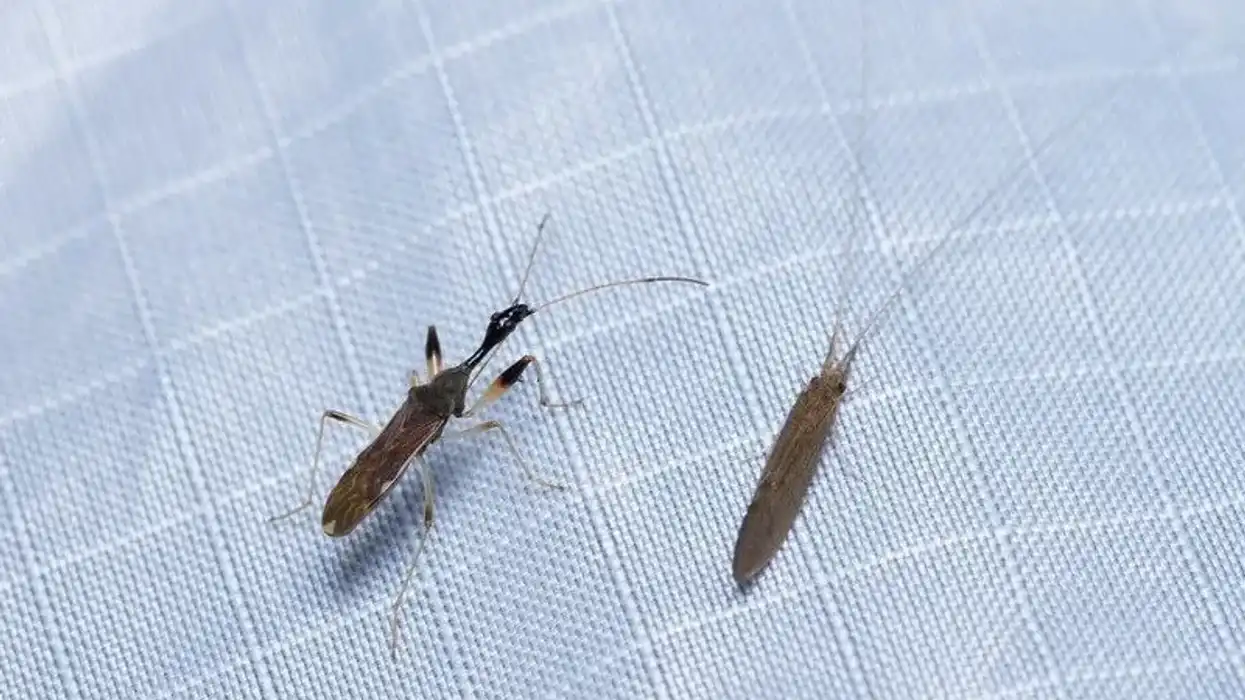When we think of underwater, we usually imagine various brightly colored creatures lying at the bottom of the ocean, right? Longnose butterflyfish is one such beautiful species that can be very attractive.
The longnose butterflyfish is a tropical marine animal adapted to living in, and near, coral reef areas, feeding on a variety of small invertebrates. It has a vibrant yellow body with an elongated snout that gives them a unique appearance. Other common names include yellow longnose butterflyfish, forceps butterflyfish, forceps fish, and long-nosed coralfish.
Long-nosed butterflyfish are among the most colorful and eye-catching patterned fish in the butterflyfish group, which may justify why they are so popular with aquarists. However, these butterflyfish require large tanks, about 75 gal (340.9 L) in size; this will give them plenty of open space to swim in.
Moreover, there should be plenty of hiding spots in the aquarium, which can be created of corals and rocks, preferably live rock.
Before looking into the details of this peaceful long-nosed butterflyfish, don't forget there are more channel catfish facts and rainbow trout facts to explore.
Longnose Butterflyfish Interesting Facts
What type of animal is a longnose butterflyfish?
The yellow longnose butterflyfish, or forceps fish, is a marine fish with a long snout found individually or in groups in the Indo-Pacific region.
What class of animal does a longnose butterflyfish belong to?
The yellow longnose butterflyfish (Forcipiger flavissimus) is a member of the class Actinopterygii of fishes, commonly characterized as ray-finned fishes, which is a subclass of bony fishes.
How many longnose butterflyfishes are there in the world?
The exact population of this species is unknown. However, this species is relatively abundant, and there is no evidence of its population decreasing.
Where does a longnose butterflyfish live?
Yellow longnose butterflyfish (Forcipiger flavissimus) is a widespread species. They can be found throughout the tropical waters of the Indo-Pacific regions, from the east coast of Africa to Hawaii.
In the North Red Sea to Japan, south to Australia in Lord Howe Island and Micronesia, and across Eastern coast in southern Baja California, Mexico Sea, including the Galapagos Islands and Revillagigedo Islands.
What is a longnose butterflyfish's habitat?
These fishes can be found along opened seaward reefs with lots of coral spread, rocky caves and ledges, and habitat at lagoon reef. They live at depths ranging from 3-476 ft (1-145 m) which includes shallow flats to very deep walls.
Who do longnose butterflyfishes live with?
If you encounter them in the wild, you will discover in pairs; however, it can occasionally be found alone or in small groups of five. Generally, a male and female fish will pair up and occupy a territory alone, usually a reef area, and chase other fishes to defend their territorial area.
How long does a longnose butterflyfish live?
It is observed that the average lifespan of these fishes is 5-10 years in an aquarium, although they can live considerably longer if proper longnose butterflyfish care is given; the longest known lifespan is 18 years.
How do they reproduce?
These fishes are monogamous pairs, like many other marine species, and reproduce in the wild through spawning or external fertilization. First, they release a large number of tiny eggs into the planktonic water column, where they float with the currents until they hatch.
After hatching from eggs, in the post-larval stage called fry, their body is coated with huge bone plates or spines that protrude from the head. These spines eventually disappear and are absorbed into the body. After entering the juvenile stage, these fishes display different color patterns.
What is their conservation status?
The IUCN Red List has classified these species as of Least Concern. This indicates that these fish are plentiful and do not require special conservation measures to survive.
Longnose Butterflyfish Fun Facts
What do longnose butterflyfishes look like?
These fishes have a bright yellow body with a black head above and silvery-white below and a notable black spot on their anal fin at the tail. Its most distinctive characteristic is the elongated snout topped with a small mouth.
It has a disc-shaped, laterally compressed body with a continuous dorsal fin and round tail fin.
A black stripe over the nape covers the upper half of the eyes, giving the appearance of a mask. The dorsal fins and anal fins are also yellow with blue-edge, whereas the pectoral and caudal fins are transparent throughout the length.
How cute are they?
These longnose butterflyfish are cute to watch with a pretty yellow color and pattern. Indeed, their vibrant look has made them a popular variety for aquariums.
How do they communicate?
They use vision to communicate and locate food as well. Interestingly, when a couple becomes separated, one of them may swim higher in a display that helps the two find each other. In addition, acoustic behaviors have been observed to communicate during territory boundaries, mating, and spawning.
It is observed that forceps fish produce three sorts of sounds: primarily, a pulse with rapid cranial elevation. Secondly, a low‐frequency pulse along with anal fin retraction and elevation. Finally, high‐frequency broadband with tail slap behavior.
How big is a longnose butterflyfish?
Coming to its size, it can grow up to 8.5 in (21.5 cm) in length.
How fast can a longnose butterflyfish swim?
Although it is unknown how fast a butterflyfish can swim, they are active swimmers that require a 75 gallon (340.9 L) aquarium tank for a single fish.
How much does a longnose butterflyfish weigh?
The average weight of long-nosed butterflyfish is yet to be determined.
What are the male and female names of the species?
There is no specific name given to distinguish male and female long-nosed butterflyfish. Longnose butterflyfish have no hermaphrodism, unlike a few other reef fishes. They are born male or female and remain so throughout their lives.
What would you call a baby longnose butterflyfish?
A baby longnose butterflyfish is generally termed a juvenile longnose butterflyfish.
What do they eat?
Yellow longnose butterflyfish are carnivorous and love to eat meaty foods. It is primarily seen picking in between corals using its long snout in the wild.
Its diet consists of various invertebrates, including rocky coral polyps and soft coral polyps, as well as small animal prey like as crustaceans, sea urchins, and brine shrimp. This fish will most likely ignore shrimp and crabs, but it may consume tubeworms and may attack urchins and starfish.
When grown in an aquarium, you need to provide them meaty foods, dried flakes, prepared frozen foods, shrimps, and tablets. Several frozen sponge-based foods are also now available to feed this territorial butterflyfish.
Their main predators are sharks, snappers, eels, and other large fishes.
Are they dangerous?
These longnose butterflyfish are not harmful. In general, it is a peaceful fish, although it can sometimes be aggressive towards other fishes as they are highly territorial.
Would they make a good pet?
If you are impressed with its look and want to add it to your aquarium, remember this fish is not suitable for reef aquariums as they are harmful to the polyps of stony and soft coral species.
One advantage of keeping it in a reef tank is that some individuals may help to rid the reef of irritating Aiptasia species such as the glass anemone (Aiptasia pulchella), though they are not as skilled at this as the raccoon butterflyfish (Chaetodon lunula) or the copperband butterfly.
In general, it is a quiet fish and does well in fish-only aquariums.
These butterflyfishes are typically kept single or as a pair in larger tanks.
It does well with other non-aggressive fish, and it can also be placed in a somewhat aggressive population if introduced into the tank early.
Smaller, non-aggressive fishes such as gobies, cardinalfish, fairy basslets, fairy, flasher wrasses, and tilefish are suitable tank mates. This species can also be kept with larger, more territorial angelfish.
But it may not be recommended to be kept with other butterflyfish, as it is aggressive towards other members of its species as well as other butterflyfish of the same genus like longnose Atlantic butterflyfish, also known as Caribbean longnose butterflyfish.
Did you know...
This fish's color pattern and look are strikingly similar to its near relative, the big long-nosed butterflyfish (Forcipiger longirostris), also known as rare longnose butterflyfish. However, the snout of the big long-nosed butterflyfish is much longer than the F. flavissimus species.
Why is the longnose butterflyfish also known as forceps butterflyfish?
Its long nose is tipped with sharp jaws resembling a pair of needle-nose pliers. It can easily snip off the tentacles of tube worms, pick up copepods and mysid shrimp, and trace other tiny prey morsels hiding in cracks and crevices using this unique nose. Henceforth it is also known as the long-nose butterflyfish and the forceps butterflyfish.
What is unique about the longnose butterflyfish?
The yellow longnose butterflyfish is a beautiful fish to observe as it moves around the tank. Its bright yellow body is emphasized by a black face mask and a distinct eyespot at the tail.
Their elongated snout, however, is its most distinguishing feature. Moreover, these fish can change color automatically based on their environment. The vibrant shades typically fade at night to blend in with the coral reefs, and when the fish feels threatened, the color becomes even more vibrant.
Here at Kidadl, we have carefully created lots of interesting family-friendly animal facts for everyone to discover! For more relatable content, check out these rainbow chichild facts and pumpkinseed sunfish facts for kids.
You can even occupy yourself at home by coloring in one of our free printable raccoon butterflyfish coloring pages.









